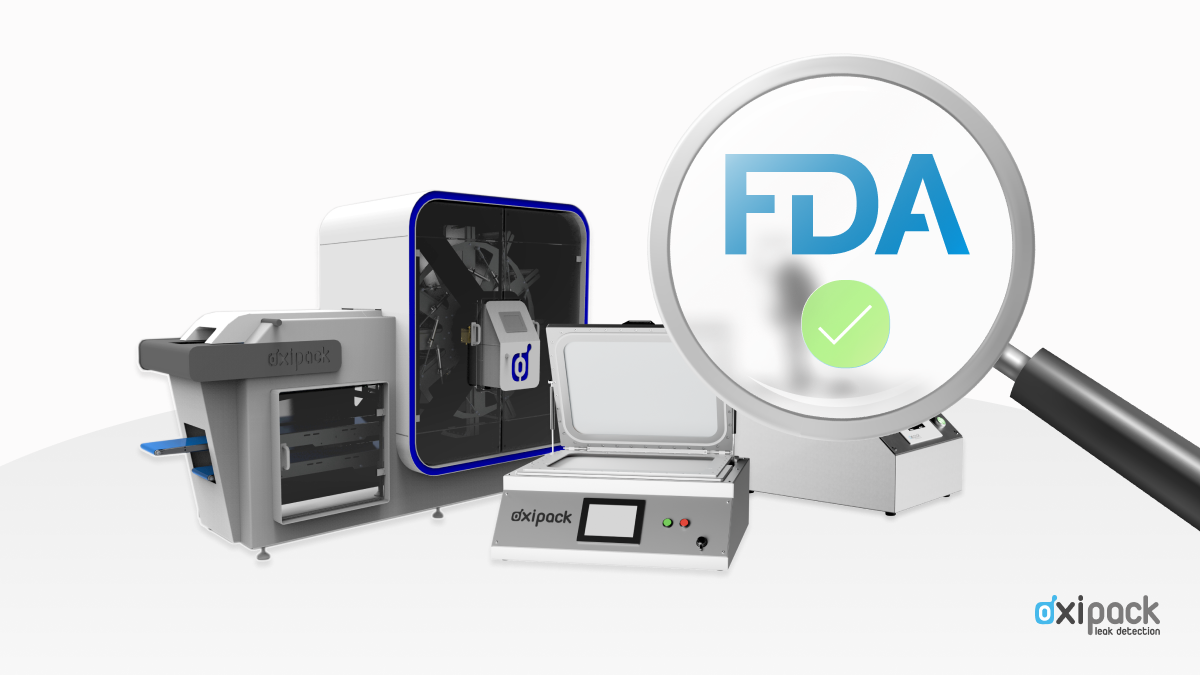According to the FDA, nearly 50% of product recalls are related to packaging and labeling issues (FDA, 2023). Ensuring compliance with the U.S. Food and Drug Administration (FDA) is a critical aspect for manufacturers in the pharmaceutical, medical device, and food industries. Packaging integrity plays a key role in this process, as any compromise can lead to contamination, product recalls, and significant regulatory penalties. Non-destructive testing methods, particularly vacuum decay testing, have emerged as a reliable solution to help manufacturers meet FDA standards without the downsides associated with traditional, destructive testing techniques. Here’s how you can achieve FDA compliance effectively with non-destructive testing.
The Role of Packaging Integrity in FDA Compliance
FDA compliance means meeting stringent standards for product safety, quality, and effectiveness. For products that must remain sterile or sealed, such as pharmaceuticals, biologics, and medical devices, packaging integrity is paramount. Packaging defects can compromise product sterility, leading to health risks for consumers and costly recalls for manufacturers.
Non-destructive testing (NDT) methods, such as vacuum decay, ensure that packaging integrity is maintained without damaging the product. Unlike traditional methods like water immersion or dye ingress testing, which are both destructive and often inconsistent, vacuum decay testing provides a repeatable, quantifiable means of assessing leaks and ensuring compliance with FDA guidelines.
Advantages of Vacuum Decay Testing for FDA Compliance
- Non-Destructive and Precise: Vacuum decay testing works by placing a package in a vacuum chamber and measuring changes in pressure to detect leaks. Because this method is non-destructive, it preserves the tested product, which is especially important in industries where products are expensive or have limited availability. The precision of vacuum decay testing makes it possible to detect even the smallest leaks that could compromise product sterility, providing the reliability needed to meet FDA requirements.
- Automation for Consistency: One of the key advantages of vacuum decay testing is its ability to be fully automated. Automation minimizes human error, ensures repeatability, and allows manufacturers to maintain consistent quality control throughout production. This level of consistency is crucial for meeting FDA standards, which demand verifiable and repeatable quality assurance processes.
- Documented Traceability: The FDA requires detailed documentation of testing processes to verify compliance. Vacuum decay systems can automatically generate data logs and reports, documenting every test conducted. This traceability is invaluable during FDA audits, as it provides clear, quantifiable evidence that manufacturers are adhering to approved quality standards. Automated documentation reduces the burden of manual record-keeping and ensures compliance without gaps.
Best Practices for Achieving FDA Compliance with NDT
1. Integrate Non-Destructive Testing Early in the Process
Integrating non-destructive testing methods like vacuum decay at the earliest stages of production can help ensure that packaging issues are identified and corrected before they become larger problems. By incorporating vacuum decay testing into both the R&D and production phases, manufacturers can validate packaging designs and maintain high-quality standards from the start.
2. Automate and Optimize Leak Detection
Automation is a game-changer when it comes to compliance. With automated vacuum decay testing systems, manufacturers can scale up production without sacrificing quality. Automation ensures that every unit is tested consistently and reliably, reducing the risk of human error. This is especially important in high-volume production settings where FDA compliance hinges on ensuring that every product meets quality and safety standards.
3. Regularly Review Regulatory Requirements
FDA guidelines are continuously updated to reflect new research, safety concerns, and industry standards. Staying informed about changes in regulations and updating quality control processes accordingly is essential for maintaining compliance. Manufacturers should establish a process for regular review of FDA regulations, ensuring that their non-destructive testing methods, such as vacuum decay, continue to meet or exceed these evolving standards.
4. Maintain Comprehensive Documentation
To meet FDA standards, it’s not enough to perform quality testing—you must also prove that it was done correctly. Vacuum decay testing systems generate detailed reports of each test, which can be archived for future reference. Maintaining thorough, easily accessible documentation will provide the traceability needed during FDA audits and help demonstrate compliance with quality standards.
5. Prioritize Training for Personnel
No matter how advanced the testing technology, human oversight is still critical. Proper training ensures that personnel understand both how to operate vacuum decay testing equipment and the importance of FDA compliance. Training also helps identify potential issues early on, as well-trained staff are better equipped to respond to testing anomalies or equipment alerts, ensuring uninterrupted compliance.
6. Real-Time Monitoring and Immediate Response
With advancements in smart manufacturing, real-time monitoring systems can be integrated with vacuum decay testing to provide immediate feedback on packaging integrity. This proactive approach allows for instant detection and correction of leaks, minimizing the risk of non-compliant products reaching the market. Real-time monitoring helps manufacturers address issues quickly, thereby enhancing compliance and reducing the risk of recalls.
Case Study: Achieving Compliance with Vacuum Decay
Consider a pharmaceutical company that switched from water immersion testing to vacuum decay testing for their sterile vials. Previously, the water immersion method was not only time-consuming but also resulted in product waste, as tested units were destroyed. By adopting vacuum decay, the company was able to maintain FDA compliance without wasting valuable product, ultimately saving both time and money.
In addition, the precision of vacuum decay testing meant that even the smallest leaks could be detected, ensuring that only compliant products reached the market. Automated documentation also helped the company streamline its audit process, making compliance verification more straightforward and efficient.
Why Non-Destructive Testing is the Future of FDA Compliance
Non-destructive testing offers a future-proof approach to achieving and maintaining FDA compliance. As the industry moves towards smarter, leaner manufacturing processes, non-destructive testing methods like vacuum decay are becoming increasingly important for ensuring packaging integrity without compromising efficiency.
The ability to automate, document, and consistently deliver reliable results makes vacuum decay testing an ideal solution for manufacturers looking to meet the rigorous standards of the FDA. In a regulatory environment where compliance is critical, non-destructive testing provides a strategic advantage—helping manufacturers maintain quality, reduce waste, and stay ahead of regulatory requirements.
Achieving FDA compliance is about more than just meeting regulatory standards—it’s about ensuring product safety, protecting consumers, and maintaining trust. Non-destructive testing methods like vacuum decay provide the reliability, precision, and efficiency needed to meet these stringent standards effectively.
By incorporating vacuum decay testing into your quality control processes, you can automate compliance, reduce waste, and enhance traceability—all while protecting your brand reputation. In a world where packaging integrity is paramount, non-destructive testing is the key to meeting FDA standards and ensuring that every product reaching the consumer is safe, effective, and of the highest quality.




